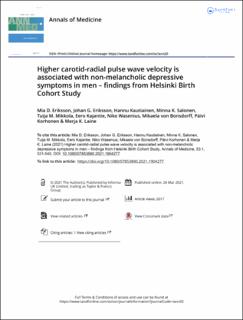| dc.contributor.author | Eriksson, Mia D. | |
| dc.contributor.author | Eriksson, Johan G. | |
| dc.contributor.author | Kautiainen, Hannu | |
| dc.contributor.author | Salonen, Minna K. | |
| dc.contributor.author | Mikkola, Tuija M. | |
| dc.contributor.author | Kajantie, Eero Olavi | |
| dc.contributor.author | Wasenius, N. S. | |
| dc.contributor.author | von Bonsdorff, Mikaela | |
| dc.contributor.author | Korhonen, Päivi | |
| dc.contributor.author | Laine, Merja K. | |
| dc.date.accessioned | 2023-02-01T13:54:11Z | |
| dc.date.available | 2023-02-01T13:54:11Z | |
| dc.date.created | 2021-12-01T11:17:35Z | |
| dc.date.issued | 2021 | |
| dc.identifier.citation | Annals of Medicine. 2021, 53 (1), 531-540. | en_US |
| dc.identifier.issn | 0785-3890 | |
| dc.identifier.uri | https://hdl.handle.net/11250/3047773 | |
| dc.description.abstract | Background: Depression and cardiovascular disease (CVD) are major causes of global disease burden that are interrelated through mostly unknown mechanisms. We studied the relationship of melancholic and non-melancholic depressive symptoms with arterial stiffness, an important underlying mechanism of CVD. Methods: The Helsinki Birth Cohort Study recruited 683 previously extensively phenotyped subjects for this sub-study. Cross-sectional data along with responses regarding depressive symptoms were obtained for each participant. For evaluation of depressive symptoms, the Beck Depression Inventory (BDI)and subscales were used to measure melancholic and non-melancholic depressive symptoms. Arterial stiffness was assessed as pulse wave velocity (PWV) that was measured between the carotid and radial artery, and carotid and femoral artery. Results: Of the participants, 532 scored <10 on the BDI and were classified as not having depressive symptoms. Of the 151 participants that scored 10 on the BDI, 122 were classified as having non-melancholic depressive symptoms and 29 as having melancholic depressive symptoms. Men had higher carotid-radial PWV (crPWV) values than women (p < .001). A positive relationship between BDI scores and crPWV (p < .001) was found in men. We also found higher crPWV in men with non-melancholic depressive symptoms compared to all others. No such differences were found in women. Discussion: Arterial stiffness has a relationship with depressive symptoms and subtypes of depressive symptoms, at least in men. There is a significant relationship between higher PWV and non-melancholic depressive symptoms in men. Due to the intricate nature of the disease causality or directionality is impossible to infer solely based on this study. Further studies into the subtypes of depressive symptoms may be of benefit to understanding depression. | en_US |
| dc.language.iso | eng | en_US |
| dc.publisher | Informa UK Limited | en_US |
| dc.rights | Navngivelse 4.0 Internasjonal | * |
| dc.rights.uri | http://creativecommons.org/licenses/by/4.0/deed.no | * |
| dc.title | Higher carotid-radial pulse wave velocity is associated with non-melancholic depressive symptoms in men–findings from Helsinki Birth Cohort Study | en_US |
| dc.title.alternative | Higher carotid-radial pulse wave velocity is associated with non-melancholic depressive symptoms in men–findings from Helsinki Birth Cohort Study | en_US |
| dc.type | Peer reviewed | en_US |
| dc.type | Journal article | en_US |
| dc.description.version | publishedVersion | en_US |
| dc.source.pagenumber | 531-540 | en_US |
| dc.source.volume | 53 | en_US |
| dc.source.journal | Annals of Medicine | en_US |
| dc.source.issue | 1 | en_US |
| dc.identifier.doi | 10.1080/07853890.2021.1904277 | |
| dc.identifier.cristin | 1962519 | |
| cristin.ispublished | true | |
| cristin.fulltext | original | |
| cristin.qualitycode | 1 | |

